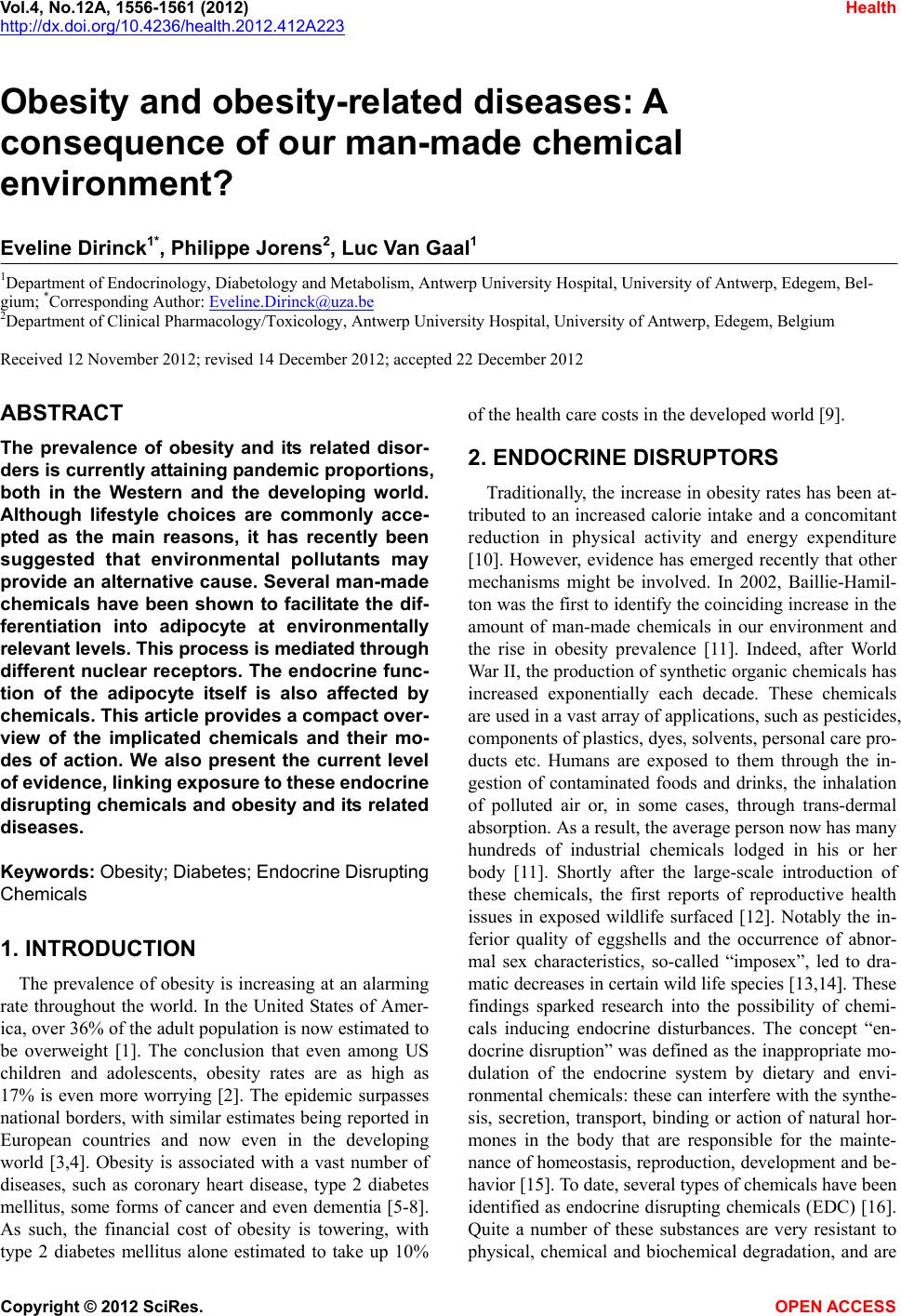 Vol.4, No.12A, 1556-1561 (2012) Health http://dx.doi.org/10.4236/health.2012.412A 223 Obesity and obesity-related diseases: A consequence of our man-made chemical environment? Eveline Dirinck1*, Philippe Jorens2, Luc Van Gaal1 1Department of Endocrinology, Diabetology and Metabolism, Antwerp University Hospital, University of Antwerp, Edegem, Bel- gium; *Corresponding Author: Eveline.Dirinck@uza.be 2Department of Clinical Pharmacology/Toxicology, Antwerp University Hospital, University of Antwerp, Edegem, Belgium Received 12 November 2012; revised 14 December 2012; accepted 22 December 2012 ABSTRACT The prevalence of obesity and its related disor- ders is currently attaining pandemic proportions, both in the Western and the developing world. Although lifestyle choices are commonly acce- pted as the main reasons, it has recently been suggested that environmental pollutants may provide an alternative cause. Several man-made chemicals have been shown to facilitate the dif- ferentiation into adipocyte at environmentally relevant levels. This process is mediated through different nuclear receptors. The endocrine func- tion of the adipocyte itself is also affected by chemicals. This article provides a compact over- view of the implicated chemicals and their mo- des of action. We also present the current level of evidence, linking exposure to the se endocrine disrupting chemicals and obesity and its related diseases. Keywords: Obesity; Diabetes; En docrine Disru pting Chemicals 1. INTRODUCTION The prevalence of obesity is increasing at an alarming rate throughout the world. In the United States of Amer- ica, over 36% of the adult population is now estimated to be overweight [1]. The conclusion that even among US children and adolescents, obesity rates are as high as 17% is even more worrying [2]. The epidemic surpasses national borders, with similar esti mates being reported in European countries and now even in the developing world [3,4]. Obesity is associated with a vast number of diseases, such as coronary heart disease, type 2 diabetes mellitus, some forms of cancer and even dementia [5-8]. As such, the financial cost of obesity is towering, with type 2 diabetes mellitus alone estimated to take up 10% of the health care costs in the developed world [9]. 2. ENDOCRINE DISRUPTORS Traditionally, the increase in ob esity rates has been at- tributed to an increased calorie intake and a concomitant reduction in physical activity and energy expenditure [10]. However, evidence has emerged recently that other mechanisms might be involved. In 2002, Baillie-Hamil- ton was the first to identify the coinciding increase in the amount of man-made chemicals in our environment and the rise in obesity prevalence [11]. Indeed, after World War II, the production of synthetic organic chemicals has increased exponentially each decade. These chemicals are used in a vast array of applications, such as pesticides, components of plastics, dyes, solvents, personal care pro- ducts etc. Humans are exposed to them through the in- gestion of contaminated foods and drinks, the inhalation of polluted air or, in some cases, through trans-dermal absorption. As a result, the average person now has ma ny hundreds of industrial chemicals lodged in his or her body [11]. Shortly after the large-scale introduction of these chemicals, the first reports of reproductive health issues in exposed wildlife surfaced [12]. Notably the in- ferior quality of eggshells and the occurrence of abnor- mal sex characteristics, so-called “imposex”, led to dra- matic decreases in certain wild life species [13,14]. The se findings sparked research into the possibility of chemi- cals inducing endocrine disturbances. The concept “en- docrine disruption” was defined as the inappropriate mo- dulation of the endocrine system by dietary and envi- ronmental chemicals: these can interfere with the synthe- sis, secretion, transport, binding or action of natural hor- mones in the body that are responsible for the mainte- nance of homeostasis, reproduction, development and be- havior [15]. To date, several types of chemicals have been identified as endocrine disrup ting chemicals (EDC) [16]. Quite a number of these substances are very resistant to physical, chemical and biochemical degradation, and are Copyright © 2012 SciRes. OPEN ACCESS 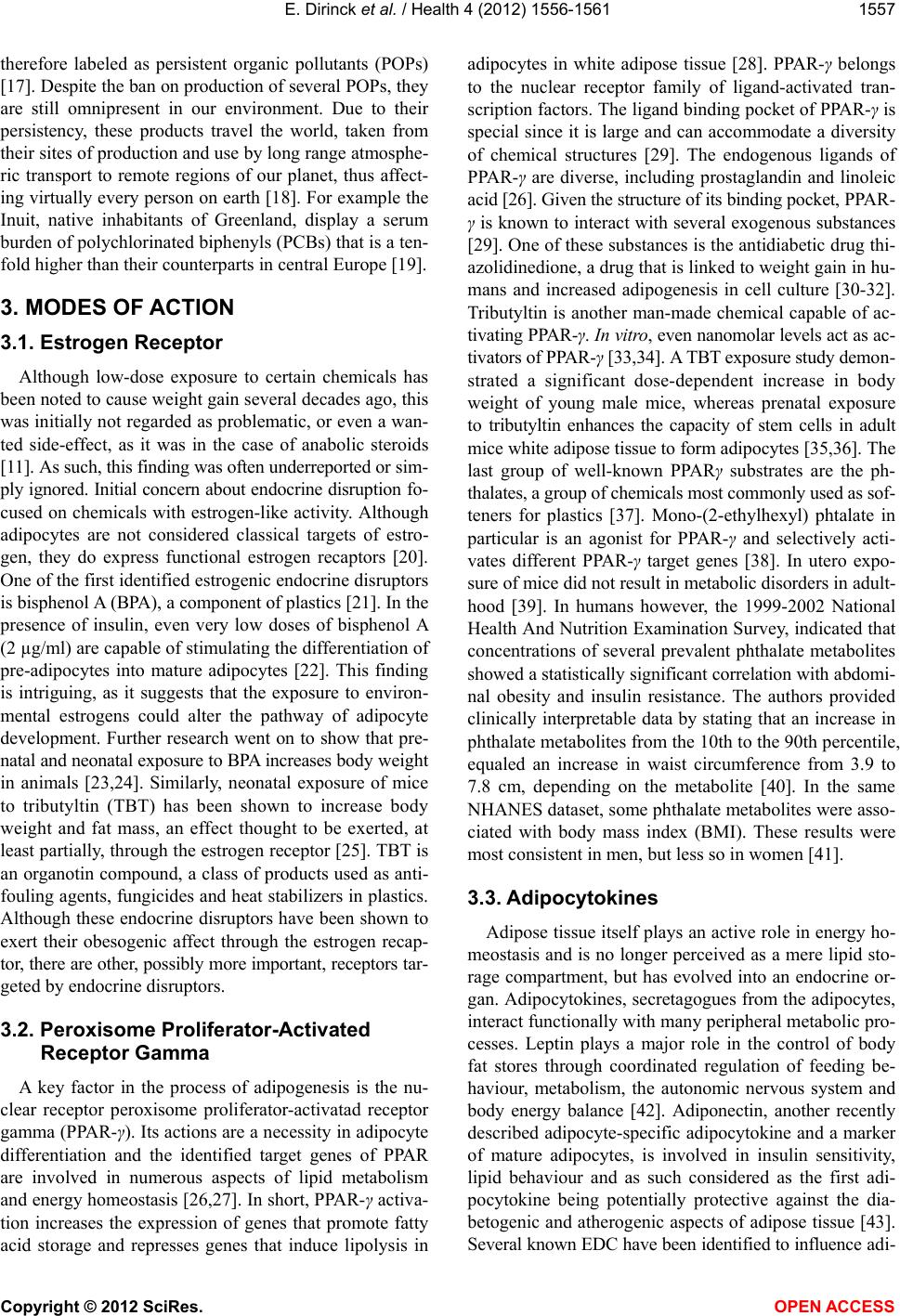 E. Dirinck et al. / Health 4 (2012) 1556-1561 155 7 therefore labeled as persistent organic pollutants (POPs) [17]. Despite the ban on production of several POPs, they are still omnipresent in our environment. Due to their persistency, these products travel the world, taken from their sites of production and use by long range atmosphe- ric transport to remote regions of our planet, thus affect- ing virtually every person on earth [18]. For example the Inuit, native inhabitants of Greenland, display a serum burden of polych lorinated b iphenyls (PCBs) that is a ten- fold higher than their counterparts in central Europe [19]. 3. MODES OF ACTION 3.1. Estrogen Receptor Although low-dose exposure to certain chemicals has been noted to cause weight gain several decades ago, this was initially not regard ed as problematic, or even a wan- ted side-effect, as it was in the case of anabolic steroids [11]. As such, this finding was often underreported or sim- ply ignored. Initial concern about endocrine disruption fo- cused on chemicals with estrogen-like activity. Although adipocytes are not considered classical targets of estro- gen, they do express functional estrogen recaptors [20]. One of the first identified estrogenic endocrine disruptors is bisphenol A (BPA), a component of plastics [21]. In the presence of insulin, even very low doses of bisphenol A (2 µg/ml) are capable of stimulating the differentiation of pre-adipocytes into mature adipocytes [22]. This finding is intriguing, as it suggests that the exposure to environ- mental estrogens could alter the pathway of adipocyte development. Further research went on to show that pre- natal and neonatal exposure to BPA in creases body w e ig h t in animals [23,24]. Similarly, neonatal exposure of mice to tributyltin (TBT) has been shown to increase body weight and fat mass, an effect thought to be exerted, at least partially, through the estr ogen receptor [25 ]. TBT is an organotin compound, a class of products used as anti- fouling agents, fu ngicides and heat stabilizers in plastics. Although these endocrine disruptors have been shown to exert their obesogenic affect through the estrogen recap- tor, there are other, possibly more important, receptors t ar- geted by endocri ne di sr u pt ors . 3.2. Peroxisome Proliferator-Activated Receptor Gamma A key factor in the process of adipogenesis is the nu- clear receptor peroxisome proliferator-activatad receptor gamma (PPAR-γ). Its actions are a necessity in adipocyte differentiation and the identified target genes of PPAR are involved in numerous aspects of lipid metabolism and energy homeostasis [26,27]. In shor t, PPAR-γ activa- tion increases the expression of genes that promote fatty acid storage and represses genes that induce lipolysis in adipocytes in white adipose tissue [28]. PPAR-γ belongs to the nuclear receptor family of ligand-activated tran- scription factors. The ligand binding pocket of PPAR-γ is special since it is large and can accommodate a diversity of chemical structures [29]. The endogenous ligands of PPAR-γ are diverse, including prostaglandin and linoleic acid [26]. Given the structure of its binding pocket, PPAR- γ is known to interact with several exogenous substanc es [29]. One of these substances is the antidiabetic drug thi- azolidinedion e, a drug th at is linked to weight ga in in hu- mans and increased adipogenesis in cell culture [30-32]. Tributyltin is another man-made chemical capable of ac- tivating PPAR-γ. In vitro, even nanomolar levels act as ac- tivators of PPAR-γ [33,34]. A TBT exposure st udy demon- strated a significant dose-dependent increase in body weight of young male mice, whereas prenatal exposure to tributyltin enhances the capacity of stem cells in adult mice white adipos e tissue to form adipocytes [35,36]. The last group of well-known PPARγ substrates are the ph- thalates, a group of chemicals m ost commonly used as sof- teners for plastics [37]. Mono-(2-ethylhexyl) phtalate in particular is an agonist for PPAR-γ and selectively acti- vates different PPAR-γ target genes [38]. In utero expo- sure of mice did not result in metabolic disorders in adult- hood [39]. In humans however, the 1999-2002 National Health And Nutrition Examination Survey, indicated th at concentrations of several prevalent phthalate metabolites showed a statistically significant correlation with abdomi- nal obesity and insulin resistance. The authors provided clinically interpretable data by stating that an increase in phthalate metabolites fro m the 10th to the 90th percen tile, equaled an increase in waist circumference from 3.9 to 7.8 cm, depending on the metabolite [40]. In the same NHANES dataset, some phthalate metabolites were asso- ciated with body mass index (BMI). These results were most consistent in men, but less so in women [41]. 3.3. Adipocytokines Adipose tissue itself plays an active role in energy ho- meostasis and is no longer perceived as a mere lipid sto- rage compartment, but has evolved into an endocrine or- gan. Adipocytokines, secr etagogues from the adipocytes, interact functionally with many periph eral metabo lic pro- cesses. Leptin plays a major role in the control of body fat stores through coordinated regulation of feeding be- haviour, metabolism, the autonomic nervous system and body energy balance [42]. Adiponectin, another recently described adipocyte-specific adipocytokine and a marker of mature adipocytes, is involved in insulin sensitivity, lipid behaviour and as such considered as the first adi- pocytokine being potentially protective against the dia- betogenic and atherogenic aspects of adipose tissue [43]. Several known EDC have been identified to influence ad i - Copyright © 2012 SciRes. OPEN ACCESS 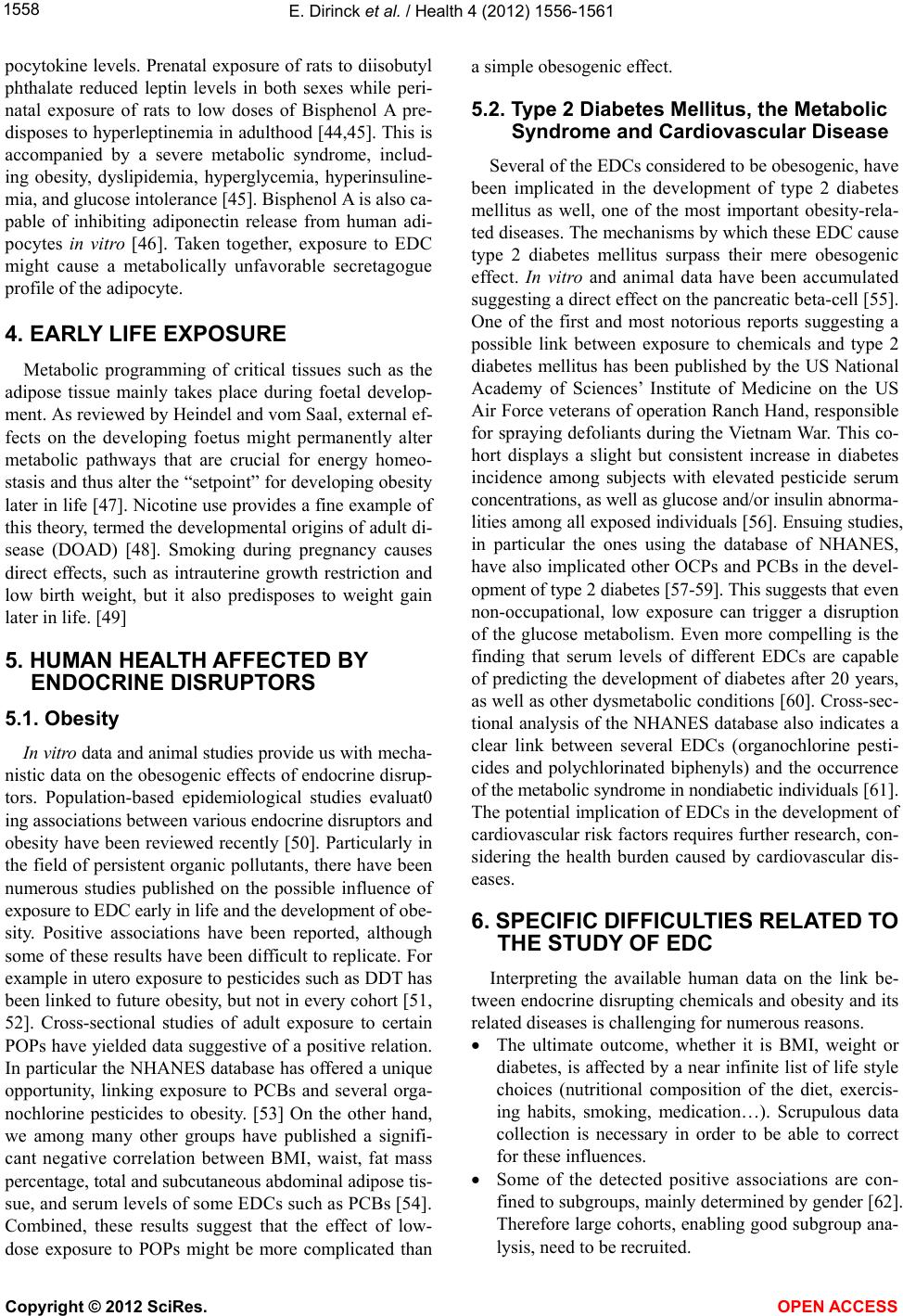 E. Dirinck et al. / Health 4 (2012) 1556-1561 1558 pocytokine levels. Pren atal exposure of rats to diisobutyl phthalate reduced leptin levels in both sexes while peri- natal exposure of rats to low doses of Bisphenol A pre- disposes to hyperleptinemia in adulthood [44,45]. This is accompanied by a severe metabolic syndrome, includ- ing obesity, dyslipidemia, hyperglycemia, hyperinsuline- mia, and glucose intolerance [45]. Bisphenol A is also ca- pable of inhibiting adiponectin release from human adi- pocytes in vitro [46]. Taken together, exposure to EDC might cause a metabolically unfavorable secretagogue profile of the adipocyte. 4. EARLY LIFE EXPOSURE Metabolic programming of critical tissues such as the adipose tissue mainly takes place during foetal develop- ment. As reviewed by Heindel and vom Saal, external ef- fects on the developing foetus might permanently alter metabolic pathways that are crucial for energy homeo- stasis and thus alter the “setpoint” for developing obesity later in life [47]. Nicotine use provides a fine example of this theory, termed the developmental origins of ad ult di- sease (DOAD) [48]. Smoking during pregnancy causes direct effects, such as intrauterine growth restriction and low birth weight, but it also predisposes to weight gain later in life. [49] 5. HUMAN HEALTH AFFECTED BY ENDOCRINE DISRUPTORS 5.1. Obesity In vitro data and animal studies provide us with me cha - nistic data on the obesogenic effects of endocrine disrup- tors. Population-based epidemiological studies evaluat0 ing associations between various endocrine disruptors and obesity have been reviewed recently [50]. Particularly in the field of persistent organic pollutants, there have been numerous studies published on the possible influence of exposure to EDC early in life and the development of obe- sity. Positive associations have been reported, although some of these results have been difficult to replicate. For example in utero exposure to pesticides such as DDT has been linked to future obesity, but not in every cohort [51, 52]. Cross-sectional studies of adult exposure to certain POPs have yielded data suggestive of a positive relatio n. In particular the NHANES database has offered a unique opportunity, linking exposure to PCBs and several orga- nochlorine pesticides to obesity. [53] On the other hand, we among many other groups have published a signifi- cant negative correlation between BMI, waist, fat mass percentage, total and subcutaneous abdominal adipose tis- sue, and serum levels of some EDCs such as PCBs [54]. Combined, these results suggest that the effect of low- dose exposure to POPs might be more complicated than a simple obesogenic effect. 5.2. Type 2 Diabetes Mellitus, the Metabolic Syndrome and Cardiovascular Disease Several of the EDCs considered to be obesogenic, have been implicated in the development of type 2 diabetes mellitus as well, one of the most important obesity-rela- ted diseases. The mechanisms by which these EDC cause type 2 diabetes mellitus surpass their mere obesogenic effect. In vitro and animal data have been accumulated suggesting a direct effect on the pancreatic beta-cell [55]. One of the first and most notorious reports suggesting a possible link between exposure to chemicals and type 2 diabetes mellitus has been published by the US National Academy of Sciences’ Institute of Medicine on the US Air Force veterans of operation Ranch Hand, responsible for spraying defoliants during the Vietnam War. This co- hort displays a slight but consistent increase in diabetes incidence among subjects with elevated pesticide serum concentrations, as well as glucose and/or insulin abnorma - lities among all exposed individuals [56]. Ensuing studies, in particular the ones using the database of NHANES, have also implicated other OCPs and PCBs in the devel- opment of type 2 diabetes [57-59]. This suggests that eve n non-occupational, low exposure can trigger a disruption of the glucose metabolism. Even more compelling is the finding that serum levels of different EDCs are capable of predicting the development of diabetes after 20 years, as well as other dysmetabolic conditions [60]. Cross-sec- tional analysis of the NHANES database also indicates a clear link between several EDCs (organochlorine pesti- cides and polychlorinated biphenyls) and the occurrence of the metabolic syndrome in nondiabetic individuals [61]. The potential implication of EDCs in the development of cardiovascular risk factors requires further research, con- sidering the health burden caused by cardiovascular dis- eases. 6. SPECIFIC DIFFICULTIES RELATED TO THE STUDY OF EDC Interpreting the available human data on the link be- tween en docrine d isrupting ch emicals and obesity and its related diseases is challenging for numerous reasons. The ultimate outcome, whether it is BMI, weight or diabetes, is affected by a near infinite list of life style choices (nutritional composition of the diet, exercis- ing habits, smoking, medication…). Scrupulous data collection is necessary in order to be able to correct for these influences. Some of the detected positive associations are con- fined to subgroups, mainly determined by gender [62]. Therefore large cohorts, enabling good subgroup ana- lysis, need to be recruited. Copyright © 2012 SciRes. OPEN ACCESS 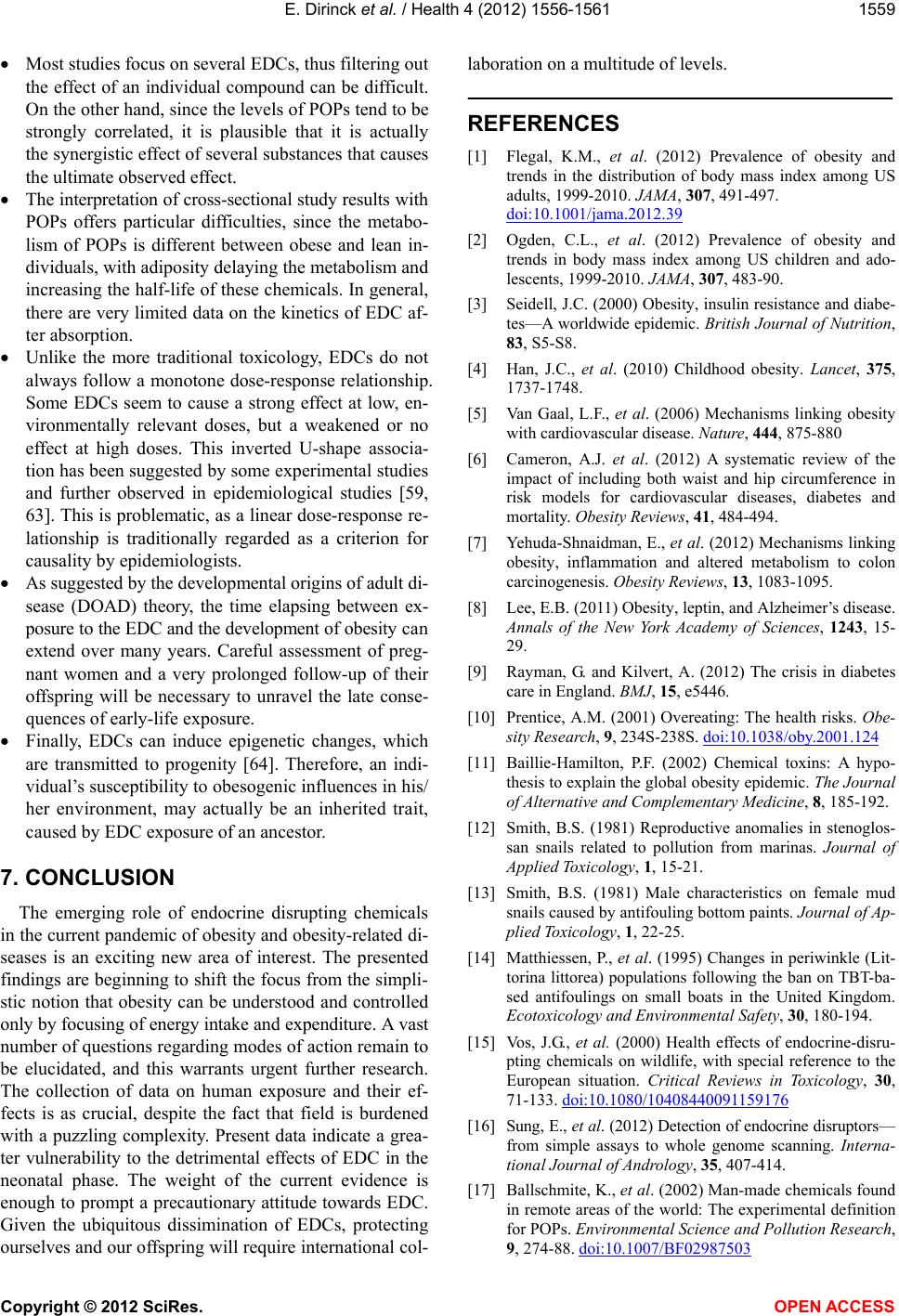 E. Dirinck et al. / Health 4 (2012) 1556-1561 155 9 Most studies focus on several EDCs, thus filtering out the effect of an individual compound can be difficult. On the other hand, since the levels of POPs tend to be strongly correlated, it is plausible that it is actually the synergistic effect of several substances that causes the ultimate observed effect. The interpretation of cross-section al study results w ith POPs offers particular difficulties, since the metabo- lism of POPs is different between obese and lean in- dividuals, with adiposity delaying the metabolism and increasing the half-life of th ese chemicals. In general, there are very limited d ata on the kinetics of EDC af- ter absorption. Unlike the more traditional toxicology, EDCs do not always follow a monotone dose-response relationship. Some EDCs seem to cause a strong effect at low, en- vironmentally relevant doses, but a weakened or no effect at high doses. This inverted U-shape associa- tion has been suggested by some experimental studies and further observed in epidemiological studies [59, 63]. This is problematic, as a linear dose-resp onse re- lationship is traditionally regarded as a criterion for causality by epidemiologists. As suggested by the deve lopmental origin s of adult di- sease (DOAD) theory, the time elapsing between ex- posure to the EDC and the development of obesity c a n extend over many years. Careful assessment of preg- nant women and a very prolonged follow-up of their offspring will be necessary to unravel the late conse- quences of early-life exposure. Finally, EDCs can induce epigenetic changes, which are transmitted to progenity [64]. Therefore, an indi- vidual’s susceptibility to obesog enic influences in his/ her environment, may actually be an inherited trait, caused by EDC exposure of an ancestor. 7. CONCLUSION The emerging role of endocrine disrupting chemicals in the current pande mic of obesity and obesity-related d i- seases is an exciting new area of interest. The presented findings are beginning to shift the focus from the simpli- stic notion that obesity can be understood and controlled only by focusing of energy intake and expenditure. A vast number of questions regarding modes of action remain to be elucidated, and this warrants urgent further research. The collection of data on human exposure and their ef- fects is as crucial, despite the fact that field is burdened with a puzzling complexity. Present data indicate a grea- ter vulnerability to the detrimental effects of EDC in the neonatal phase. The weight of the current evidence is enough to prompt a precautio nary attitude towards EDC. Given the ubiquitous dissimination of EDCs, protecting ourselves and our offspring will require international col- laboration on a multitud e of levels. REFERENCES [1] Flegal, K.M., et al. (2012) Prevalence of obesity and trends in the distribution of body mass index among US adults, 1999-2010. JAMA, 307, 491-497. doi:10.1001/jama.2012.39 [2] Ogden, C.L., et al. (2012) Prevalence of obesity and trends in body mass index among US children and ado- lescents, 1999-2010. JAMA, 307, 483-90. [3] Seidell, J.C. (2000) Obesity, insulin resistance and diabe- tes—A worldwide epidemic. British Journal of Nutrition, 83, S5-S8. [4] Han, J.C., et al. (2010) Childhood obesity. Lancet, 375, 1737-1748. [5] Van Gaal, L.F., et al. (2006) Mechanisms linking obesity with cardiovascular disease. Nature, 444, 875-880 [6] Cameron, A.J. et al. (2012) A systematic review of the impact of including both waist and hip circumference in risk models for cardiovascular diseases, diabetes and mortality. Obesity Reviews, 41, 484-494. [7] Yehuda-Shnaidman, E., et al. (2012) Mechanisms linking obesity, inflammation and altered metabolism to colon carcinogenesis. Obesity Reviews, 13, 1083-1095. [8] Lee, E.B. (2011) Obesity, leptin, and Alzheimer’s disease. Annals of the New York Academy of Sciences, 1243, 15- 29. [9] Rayman, G. and Kilvert, A. (2012) The crisis in diabetes care in England. BMJ, 15, e5446. [10] Prentice, A.M. (2001) Overeating: The health risks. Obe- sity Research, 9, 234S-238S. doi:10.1038/oby.2001.124 [11] Baillie-Hamilton, P.F. (2002) Chemical toxins: A hypo- thesis to explain the global obesity epidemic. The Journal of Alternative and Complementary Medicine, 8, 185-192. [12] Smith, B.S. (1981) Reproductive anomalies in stenoglos- san snails related to pollution from marinas. Journal of Applied Toxicology, 1, 15-21. [13] Smith, B.S. (1981) Male characteristics on female mud snails caused by antifouling bottom paints. Journal of Ap- plied Toxicology, 1, 22-25. [14] Matthiessen, P., et al. (1995) Changes in periwinkle (Lit- torina littorea) populations following the ban on TBT-ba- sed antifoulings on small boats in the United Kingdom. Ecotoxicology and Environmental Safety, 30, 180-194. [15] Vos, J.G., et al. (2000) Health effects of endocrine-disru- pting chemicals on wildlife, with special reference to the European situation. Critical Reviews in Toxicology, 30, 71-133. doi:10.1080/10408440091159176 [16] Sung, E., et al. (2012) Detection of endocrine disrupto rs— from simple assays to whole genome scanning. Interna- tional Journal of Andrology, 35, 407-414. [17] Ballschmite, K., et al. (2002) Man-made chemicals found in remote areas of the world: The experimental definition for POPs. Environmental Science and Pollution Research, 9, 274-88. doi:10.1007/BF02987503 Copyright © 2012 SciRes. OPEN ACCESS 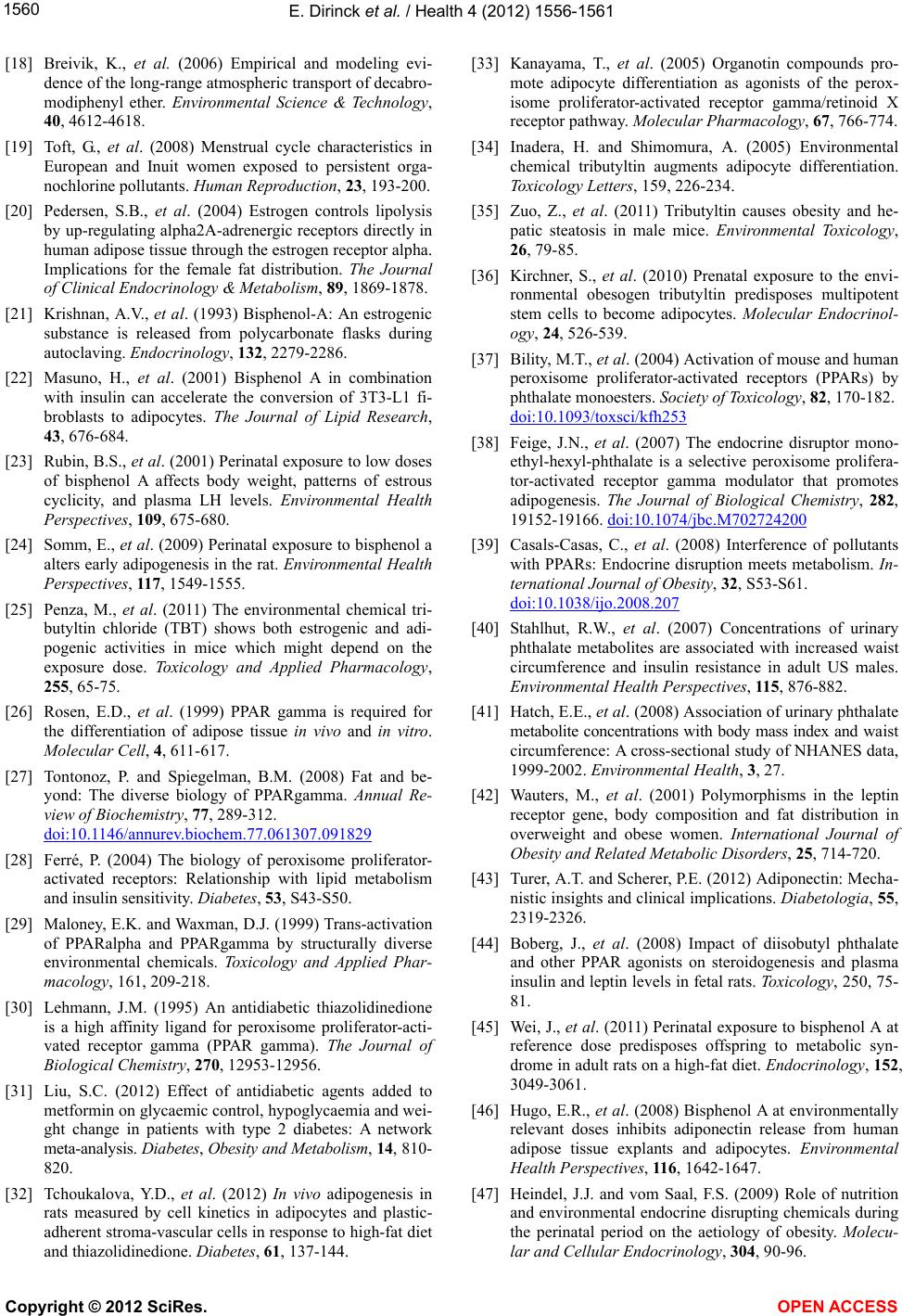 E. Dirinck et al. / Health 4 (2012) 1556-1561 1560 [18] Breivik, K., et al. (2006) Empirical and modeling evi- dence of the long-range atmospheric transport of decabro- modiphenyl ether. Environmental Science & Technology, 40, 4612-4618. [19] Toft, G., et al. (2008) Menstrual cycle characteristics in European and Inuit women exposed to persistent orga- nochlorine pollutants. Human Reproduction, 23, 193-200. [20] Pedersen, S.B., et al. (2004) Estrogen controls lipolysis by up-regulating alpha2A-adrenergic receptors directly in human adipose tissue through the estrogen receptor alpha. Implications for the female fat distribution. The Journal of Clinical Endocrinology & Metabolism, 89, 1869-1878. [21] Krishnan, A.V., et al. (1993) Bisphenol-A: An estrogenic substance is released from polycarbonate flasks during autoclaving. Endocrinology, 132, 2279-2286. [22] Masuno, H., et al. (2001) Bisphenol A in combination with insulin can accelerate the conversion of 3T3-L1 fi- broblasts to adipocytes. The Journal of Lipid Research, 43, 676-684. [23] Rubin, B.S., et al. (2001) Perinatal exposure to low doses of bisphenol A affects body weight, patterns of estrous cyclicity, and plasma LH levels. Environmental Health Perspectives, 109, 675-680. [24] Somm, E., et al. (2009) Perinatal exposure to bisphenol a alters early adipogenesis in the rat. Environmental Health Perspectives, 117, 1549-1555. [25] Penza, M., et al. (2011) The environmental chemical tri- butyltin chloride (TBT) shows both estrogenic and adi- pogenic activities in mice which might depend on the exposure dose. Toxicology and Applied Pharmacology, 255, 65-75. [26] Rosen, E.D., et al. (1999) PPAR gamma is required for the differentiation of adipose tissue in vivo and in vitro. Molecular Cell, 4, 611-617. [27] Tontonoz, P. and Spiegelman, B.M. (2008) Fat and be- yond: The diverse biology of PPARgamma. Annual Re- view of Biochemistry, 77, 289-312. doi:10.1146/annurev.biochem.77.061307.091829 [28] Ferré, P. (2004) The biology of peroxisome proliferator- activated receptors: Relationship with lipid metabolism and insulin sensitivity. Diabetes, 53, S43-S50. [29] Maloney, E.K. and Waxman, D.J. (1999) Trans-activation of PPARalpha and PPARgamma by structurally diverse environmental chemicals. Toxicology and Applied Phar- macology, 161, 209-218. [30] Lehmann, J.M. (1995) An antidiabetic thiazolidinedione is a high affinity ligand for peroxisome proliferator-acti- vated receptor gamma (PPAR gamma). The Journal of Biological Chemistry, 270, 12953-12956. [31] Liu, S.C. (2012) Effect of antidiabetic agents added to metformin on glycaemic control, hypoglycaemia and wei- ght change in patients with type 2 diabetes: A network meta-analysis. Diabetes, Obesity and Metabolism, 14, 810- 820. [32] Tchoukalova, Y.D., et al. (2012) In vivo adipogenesis in rats measured by cell kinetics in adipocytes and plastic- adherent stroma-vascular cells in response to high-fat diet and thiazolidinedione. Diabetes, 61, 137-144. [33] Kanayama, T., et al. (2005) Organotin compounds pro- mote adipocyte differentiation as agonists of the perox- isome proliferator-activated receptor gamma/retinoid X receptor pathway. Molecular Pharmacology, 67, 766-774. [34] Inadera, H. and Shimomura, A. (2005) Environmental chemical tributyltin augments adipocyte differentiation. Toxicology Letters, 159, 226-234. [35] Zuo, Z., et al. (2011) Tributyltin causes obesity and he- patic steatosis in male mice. Environmental Toxicology, 26, 79-85. [36] Kirchner, S., et al. (2010) Prenatal exposure to the envi- ronmental obesogen tributyltin predisposes multipotent stem cells to become adipocytes. Molecular Endocrinol- ogy, 24, 526-539. [37] Bility, M.T., et al. (2004) Activation of mouse and human peroxisome proliferator-activated receptors (PPARs) by phthalate monoesters. Society of Toxicology, 82, 170-182. doi:10.1093/toxsci/kfh253 [38] Feige, J.N., et al. (2007) The endocrine disruptor mono- ethyl-hexyl-phthalate is a selective peroxisome prolifera- tor-activated receptor gamma modulator that promotes adipogenesis. The Journal of Biological Chemistry, 282, 19152-19166. doi:10.1074/jbc.M702724200 [39] Casals-Casas, C., et al. (2008) Interference of pollutants with PPARs: Endocrine disruption meets metabolism. In- ternational Journal of Obesity, 32, S53-S61. doi:10.1038/ijo.2008.207 [40] Stahlhut, R.W., et al. (2007) Concentrations of urinary phthalate metabolites are associated with increased waist circumference and insulin resistance in adult US males. Environmental Health Perspectives, 11 5, 876-882. [41] Hatch, E.E., et al. (2008) Association of urinary phthalate metabolite concentrations with body mass index and w aist circumference: A cross-sectional study of NHANES data, 1999-2002. Environmental Health, 3, 27. [42] Wauters, M., et al. (2001) Polymorphisms in the leptin receptor gene, body composition and fat distribution in overweight and obese women. International Journal of Obesity and Related Metabolic Disorders, 25, 714-720. [43] Turer, A.T. and Scherer, P.E. (2012) Adiponectin: Mecha- nistic insights and clinical implications. Diabetologia, 55, 2319-2326. [44] Boberg, J., et al. (2008) Impact of diisobutyl phthalate and other PPAR agonists on steroidogenesis and plasma insulin and leptin levels in fetal rats. Toxicology, 250, 75- 81. [45] Wei, J., et al. (2011) Perinatal exposure to bisphenol A at reference dose predisposes offspring to metabolic syn- drome in adult rats on a high-fat diet. Endocrinology, 152, 3049-3061. [46] Hugo, E.R., et al. (2008) Bisphenol A at environmentally relevant doses inhibits adiponectin release from human adipose tissue explants and adipocytes. Environmental Health Perspectives, 116, 1642-1647. [47] Heindel, J.J. and vom Saal, F.S. (2009) Role of nutrition and environmental endocrine disrupting chemicals during the perinatal period on the aetiology of obesity. Molecu- lar and Cellular Endocrinology, 304, 90-96. Copyright © 2012 SciRes. OPEN ACCESS  E. Dirinck et al. / Health 4 (2012) 1556-1561 Copyright © 2012 SciRes. OPEN ACCESS 1561 [48] Newbold, R.R., et al. (2007) Developmental exposure to endocrine disruptors and the obesity epidemic. Reproduc- tive Toxicology, 23, 290-296. doi:10.1016/j.reprotox.2006.12.010 [49] Beyerlein, A., et al (2011) Is low birth weight in the causal pathway of the association between maternal smo- king in pregnancy and higher BMI in the offspring? European Journal of Epidemiology, 26, 413-420. [50] Tang-Péronard, J.L., et al. (2011) Endocrine-disrupting chemicals and obesity development in humans: A review. Obesity Reviews, 12, 622-636. [51] Karmaus, W., et al. (2009) Maternal levels of dichlorodi- phenyl-dichloroethylene (DDE) may increase weight and body mass index in adult female offspring. Occupational and Environmental Medicine, 66, 143-149. [52] Gladen, B.C., et al. (2004) Prenatal DDT exposure in re- lation to anthropometric and pubertal measures in adoles- cent males. Environmental Health Perspectives, 112, 1761- 1767. [53] Elobeid, M.A., et al. (2010) Endocrine disruptors and obesity: An examination of selec ted persistent organic po l- lutants in the NHANES 1999-2002 data. International Journal of Environmental Research and Public Health, 7, 2988-3005. [54] Dirinck, E., et al. (2011) Obesity and persistent organic pollutants: Possible obesogenic effect of organochlorine pesticides and polychlorinated biphenyls. Obesity, 19, 709-714. [55] Hectors, T.L., et al. (2011) Environmental pollutants and type 2 diabetes: A review of mechanisms that can disrupt beta cell function. Diabetologia, 54, 1273-1290. [56] Henriksen, G.L., et al. (1997) Serum dioxin and diabetes mellitus in veterans of Operation Ranch Hand. Epidemio- logy, 8, 252-258. [57] Everett, C.J., et al. (2007) Association of a polychlori- nated dibenzo-p-dioxin, a polychlorinated biphenyl, and DDT with diabetes in the 1999-2002 National Health and Nutrition Examination Survey. Environmental Research, 103, 413-418. [58] Lee, D.-H., et al. (2006) A strong dose-response relation between serum concentrations of persistent organic pollu- tants and diabetes: Results from the National Health and Examination Survey 1999-2002. Diabetes Care, 29, 1638- 1644. doi:10.2337/dc06-0543 [59] Lee, D.-H., et al. (2007) Extended analysis of the asso- ciation between serum concentrations of persistent orga- nic pollutants and diabetes. Diabetes Care, 30, 1596- 1598. doi:10.2337/dc07-0072 [60] Lee, D.-H., et al. (2010) Low dose of some persistent organic pollutants predicts type 2 diabetes: A nested case- control study. Environmental Health Perspectives, 11 8, 1235-1242. doi:10.1289/ehp.0901480 [61] Lee, D.H., et al. (2007) Relationship between serum con- centrations of persistent organic pollutants and the preva- lence of metabolic syndrome among non-diabetic adults: results from the National Health and Nutrition Examina- tion Survey 1999-2002. Diabetologia, 50, 1841-1851. [62] Gladen, B.C., et al. (2000) Pubertal growth and develop- ment and prenatal and lactational exposure to polychlori- nated biphenyls and dichlorodiphenyl dichloroethene. Journal of Pediatrics, 136, 490-496. doi:10.1016/S0022-3476(00)90012-X [63] Welshons, W.V., et al. (2006) Large effects from small exposures. III. Endocrine mechanisms mediating effects of bisphenol A at levels of human exposure. Endocrinol- ogy, 147, S56-S69. doi:10.1210/en.2005-1159 [64] Wolstenholme, J.T., et al. (2012) Gestational exposure to bisphenol a produces transgenerational changes in beha- viors and gene expression. Endocrinology, 153, 3828-3838.
|